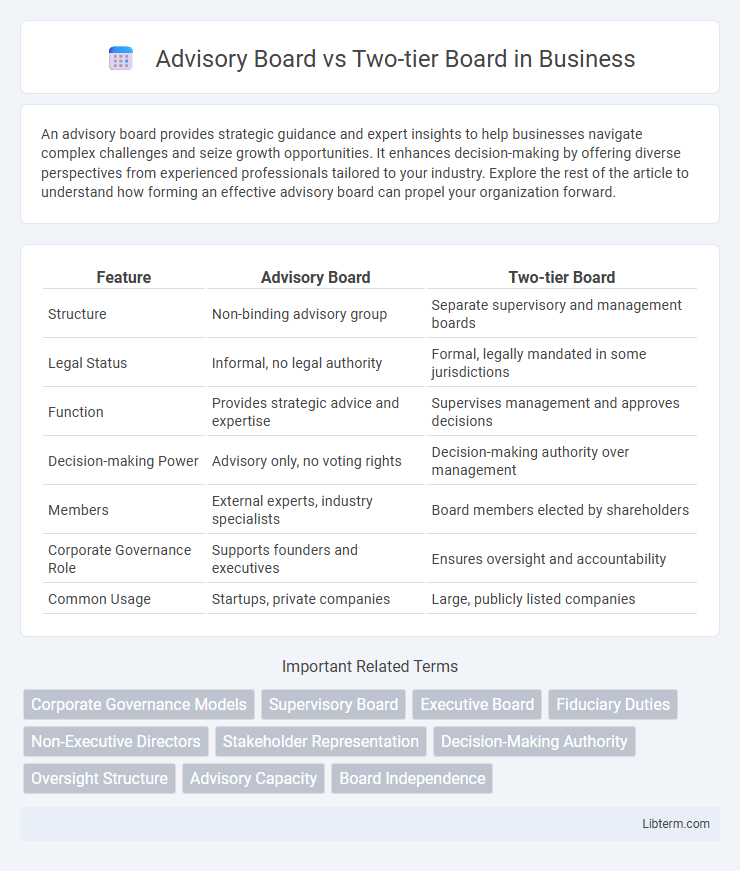An advisory board provides strategic guidance and expert insights to help businesses navigate complex challenges and seize growth opportunities. It enhances decision-making by offering diverse perspectives from experienced professionals tailored to your industry. Explore the rest of the article to understand how forming an effective advisory board can propel your organization forward.
Table of Comparison
| Feature | Advisory Board | Two-tier Board |
|---|---|---|
| Structure | Non-binding advisory group | Separate supervisory and management boards |
| Legal Status | Informal, no legal authority | Formal, legally mandated in some jurisdictions |
| Function | Provides strategic advice and expertise | Supervises management and approves decisions |
| Decision-making Power | Advisory only, no voting rights | Decision-making authority over management |
| Members | External experts, industry specialists | Board members elected by shareholders |
| Corporate Governance Role | Supports founders and executives | Ensures oversight and accountability |
| Common Usage | Startups, private companies | Large, publicly listed companies |
Introduction to Corporate Governance Structures
Advisory boards provide non-binding strategic advice without legal decision-making authority, enhancing corporate governance by offering expert insights and diverse perspectives. Two-tier boards, commonly found in countries like Germany, consist of a management board handling daily operations and a supervisory board overseeing and appointing management, ensuring a separation of powers and stronger oversight. These distinct governance structures reflect varying approaches to balancing control, accountability, and stakeholder interests in corporate management.
Defining the Advisory Board
An Advisory Board is a group of experts who provide non-binding strategic advice to a company's management without formal governance responsibilities, unlike a Two-tier Board that includes separate supervisory and management boards with distinct legal duties. Advisory Boards offer specialized knowledge and industry insights to support decision-making, foster innovation, and enhance business growth. Their role is consultative, lacking the decision-making authority held by directors in a Two-tier Board structure, which balances oversight and executive functions.
Understanding the Two-tier Board System
The two-tier board system consists of a management board responsible for day-to-day operations and a supervisory board overseeing and monitoring management decisions, enhancing corporate governance through a clear separation of roles. This structure promotes accountability by allowing the supervisory board to represent shareholders' and stakeholders' interests independently from executive management. Common in countries like Germany and the Netherlands, the two-tier system contrasts with advisory boards by granting formal authority and legal responsibilities to the supervisory board.
Key Roles and Responsibilities
An Advisory Board primarily provides non-binding strategic advice, industry expertise, and networking opportunities to a company's management without formal decision-making authority. In contrast, a Two-tier Board system consists of a Management Board responsible for daily operations and a Supervisory Board tasked with oversight, approval of major decisions, and safeguarding shareholder interests. The Supervisory Board holds fiduciary duties and legally mandated powers, making it a critical governance mechanism in countries like Germany and the Netherlands.
Decision-Making Processes Compared
An Advisory Board offers non-binding strategic advice without direct involvement in decision-making, allowing management to maintain full control while benefiting from expert insights. In contrast, a Two-tier Board structure separates supervisory and management boards, where the supervisory board actively oversees and approves key decisions, ensuring more formalized governance and accountability. This dual-layer system enhances checks and balances, resulting in a more rigorous and transparent decision-making process compared to the consultative role of an Advisory Board.
Advantages of an Advisory Board
An Advisory Board provides flexible expertise and strategic guidance without the legal responsibilities and formalities of a Two-tier Board, allowing faster decision-making and adaptability to market changes. Companies benefit from direct access to industry specialists who offer unbiased insights and innovative solutions, improving overall governance quality. This structure also costs less to maintain than a Two-tier Board, making it ideal for startups and growing businesses seeking expert advice without increasing administrative burden.
Benefits of a Two-tier Board
A two-tier board structure, consisting of a supervisory board and a management board, enhances corporate governance by providing clear separation between oversight and executive functions, reducing conflicts of interest. This separation promotes more effective monitoring of management decisions, increasing transparency and accountability to shareholders. The dual-board system also facilitates diverse expertise and stakeholder representation, which supports balanced strategic decision-making and long-term value creation.
Challenges and Limitations of Each Model
Advisory boards often face challenges related to limited formal authority, which can restrict their influence on strategic decisions and lead to reliance on the managing board's willingness to implement recommendations. Two-tier boards, consisting of supervisory and management layers, may encounter communication barriers and slower decision-making processes due to role separation and complex governance structures. Both models can experience limitations in accountability and agility, impacting efficiency in rapidly changing business environments.
Factors Influencing Board Structure Selection
Factors influencing the selection between an Advisory Board and a Two-tier Board include company size, regulatory requirements, and governance complexity. Advisory Boards typically suit smaller or startup companies seeking expert guidance without formal decision-making authority. Two-tier Boards, mandated in countries like Germany, provide a clear separation between management and supervisory roles, offering enhanced oversight for larger, publicly listed firms.
Advisory Board vs Two-tier Board: Which is Right for Your Organization?
Advisory boards provide non-binding strategic guidance without formal decision-making authority, ideal for startups or organizations seeking expert insights with flexibility. Two-tier boards, featuring separate supervisory and management boards, ensure structured governance and clear oversight, commonly used in European corporations to balance control and accountability. Choosing between an advisory board and a two-tier board depends on factors like organizational size, regulatory environment, and the need for formal governance versus flexible advice.
Advisory Board Infographic

 libterm.com
libterm.com